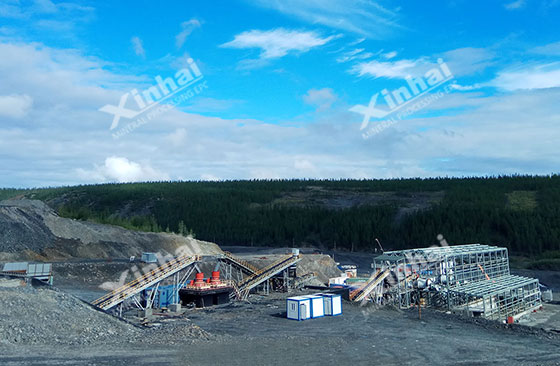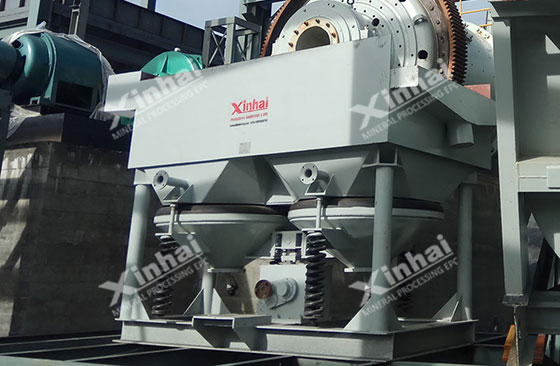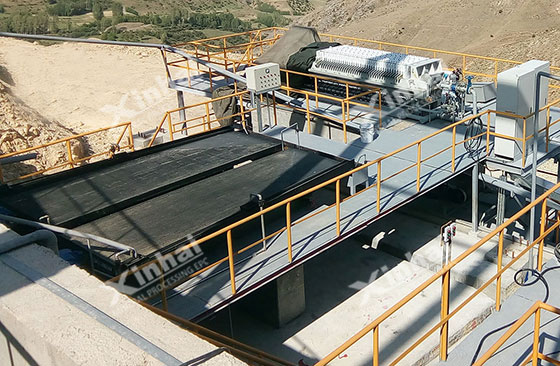
Gravity separation method is to separate the minerals according to their relative density (usually called specific gravity). The mineral particles with different densities are subject to hydrodynamic and mechanical forces in the moving medium (water, air and heavy liquid), resulting in suitable conditions for loose layering and separation, thus separating ore particles with different densities.

Gravity separation method is one of the oldest and most common gold mining processes. In the sand gold deposits, the gold usually exists in the form of monomer natural gold, and its particle size is generally more than 16t/m3, which has a big difference with gangue density, so the gravity separation method is the most effective and economic gold mining process. However, the gravity separation method is rarely used alone in lode gold mining. Generally, adopting the jigging machine and spiral chute with the shaking table in the grinding and classifying stage to recover the dissociated coarse monomer gold in advance, which facilitates the subsequent froth flotation and cyaniding process to obtain the qualified gold concentrate.
The main equipment used for gravity separation method includes various forms of chutes, jigging machine and shaking table, which has different features used in the gold mining.
Jigging process is a kind of gold mining process that uses a jigging machine as the gold mining machine. As a common gravity separation machine, there are various kinds of jigging machines. At present, diaphragm jig is often used in the gold mining plants.

The working principle of the diaphragm jig: When the eccentric drive mechanism drives the diaphragm for reciprocating movement, the water in the jig room will pass through the screen and produce vertical alternating pulsation water flow. The selected material is fed to the bed, and form a grain group system with the bed ore and water. When the water flow impinges upward, the grains are in a state of loose suspension. At this point, the ore grains with different weight and size settle at different speeds, and the large-density coarse grains settle at the lower layer. When the water flow falls, large-density fine grains enter the lower layer through the gap between beds.
Shaking table process is a kind of gold mining process with shaking table as the main equipment. The shaking table is the mineral processing equipment used in the horizontal medium flow, consisting of the bed surface and the transmission mechanism. The bed surface is driven by the transmission mechanism for longitudinal reciprocating motion. The ore separation is completed step by step in the process of reciprocating movement of the bed surface. In addition to its own gravity, the main factors contributing to the movement of ore particles are impulse flow and differential motion of the bed surface. The ore grains are effected by the delamination effect that is perpendicular to the bed surface and the separation effect that is parallel to the bed surface during movement. Therefore, the different ore particles are discharged from different zones of the bed surface.

The shaking table can be divided into coarse sand shaking bed (>0.5 mm), fine sand shaking bed (0.5 ~ 0.074 mm) and mud shaking bed (0.074 ~ 0.037 mm) according to the size of the selected ore.
Chute for gold mining is an ancient and still used gravity separation method. And the chute is the main equipment used in the gold mining, which is a narrow wooden (or steel) chute with a dip angle of 3° - 4° (maximum of 14° ~ 16°).

The working principle of the chute: After the slurry is fed into the chute from the head of the trough, the ore particles with different densities are loosely stratified and separated under the combined action of water flow force, gravity (or centrifugal force) of ore particles, friction between ore particles and the bottom of the trough. The ore particles with large density at the bottom of the chute are the concentrate, and the ore particles with small density is the tailings. The chute is an intermittent operation. When the concentrate that deposits at the bottom of the chute reaches a certain height, the ore feeding is stopped and the concentrate is discharged.
The chute is divided into the coarse sand chute and slime chute. The coarse sand chute is suitable to deal with coarse-grained material, while the slime chute is often used to deal with fine-grained material.
The spiral concentrator uses the comprehensive effect of gravity, friction force, centrifugal force and water flow to separate ore particles according to specific gravity, particle size and shape. It is characterized by the entire chute bending into a spiral in the vertical direction.
The working principle of spiral concentrator: the pulp is fed from above the chute, flows downward in a spiral line along the chute. During the flow, the ore grains are stratified. The large particles with small density are distributed on the outer edge of the spiral groove, while the small particles with large density are distributed on the inner edge of the spiral groove. The heavy product after stratification is discharged by the discharge port at the bottom of the inner groove by an interceptor, while the light product is discharged by the end of the spiral groove.
The spiral concentrator is featured with simple structure, easy to manufacture, and no transmission mechanism, without power. But it has the poor separation effect when deals with the ore that is larger than 6 mm and smaller than 0.05 mm, and the material contains flat gangue.
Separating cone is developed based on the principle of pinched sluice (also known as fan chute). The pinched sluice is fan-shaped, with a length of about 1 meter, a width of 125-400 mm at the feed end and 25-9 mm at the drain end.
Pulp from the center of the upper end into the distribution cone distribution into the other cone. The ore particles are stratified according to the density during the flow process on the sorting cone, and finally the cutting port separates the light and heavy products. There is also a kind of reichert cone concentrator widely used in the preprocessing of placer gold.
To find out more about our products and solutions, please fill out the form below and one of our experts will get back to you shortly.